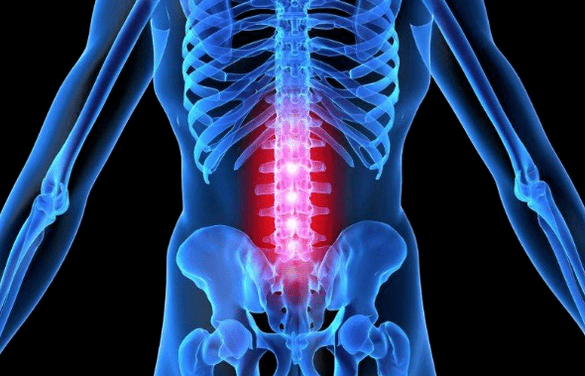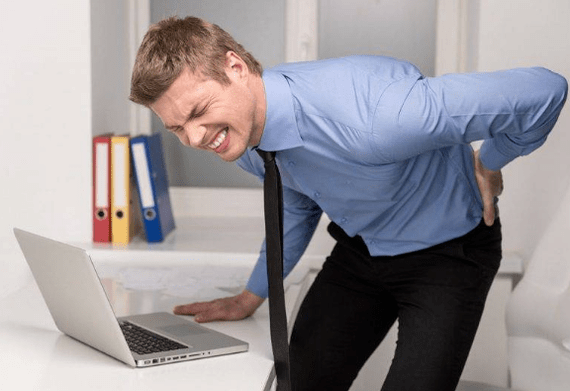Lower back pain most often affects people after 35 years.In the greater part of the cases, the disease is associated with the deformation of the vertebrae and its consequences.A timely appeal to the doctor will accelerate recovery, as the symptoms and treatment of osteochondrosis of the lumbar spine are interconnected concepts.

The greater the progress of the disease, the more serious the consequences, the more difficult the process of restoring health.
Signs and symptoms of osteochondrosis of the lumbar spine
The lumbar region is located between the sacrum and the breast department and consists of five vertebrae connected to intervertebral discs.
The development of osteochondrosis means the wear of the intervertebral discs, which play the role of shock -absorbent role in the loads of the spine.The base of the discs is a gel -like mass protected from a thick fibrous ring and cartilage, and the inner space is filled with a liquid pulpal core.
Because the loads of the vertebrae, the elasticity and flexibility of the intervertebral discs are lost, their height and the micro -msans are formed in the fibrous ring, which over time leads to rupture and damage to the amvone nucleus.
The destruction of the tissues is accompanied by a pinch of nerve roots located on both sides of the vertebrae and causes severe pain.
The main signs of lumbar osteochondrosis:
- back pain;
- fatigue and depression;
- weakness or excessive muscle tension;
- loss of sensitivity in the limbs, buttocks or thighs;
- Acute or pain in pain and cramps in the lower back often give the legs;
- Motor function impairment.
Against the background of serious vertebrae lesions, other symptoms in the lumbar region are also observed, most often the dysfunction of other organs -urine and the sexual system, the gastrointestinal tract.
Reasons
Like most diseases of the musculoskeletal system, osteochondrosis can develop for many reasons.Some of them are hidden in the way of life and the diet, the other part develops against the background of the physiological characteristics of the body.
Quite often, the treatment of osteochondrosis of the lumbosacral spine is required by athletes whose back is subjected not only by constant power loads but also by periodic injuries.
The second category of people who are at risk, people who, by virtue of their profession, spend a lot of time in one position - teachers, hairdressers, cooks, loaders, waiters, programmers, office workers and drivers.
Among other reasons for the development of the pathology:
- Excess weight;
- impaired metabolism;
- Improper stand, stop;
- genetic predisposition;
- Injuries;
- bad habits;
- lack of beneficial trace elements and vitamins in the diet;
- Abnormal development of the musculoskeletal system, flat legs;
- hypothermia;
- sedimentary, static;
- Common voltages.
All these factors can affect the elasticity of the intervertebral discs, as they contribute to disruption of blood circulation or the occurrence of a deficiency of nutrients entering the vertebrate animals.
Degree of osteochondrosis of the lumbar spine
Depending on the level of damage to the spine, the four degrees of development of osteochondrial processes are distinguished, manifest in stages as the disease develops.
The first degree.
The pathological processes in the spine begin long before their first clinical manifestation.As a result, moisture losses, the intervertebral discs become less elastic.The height of the discs is stored normally.The patient experiences discomfort in the lower back.
The second degree.
Against the background of moisture deficiency, the microbots appear in the fibrous ring and develop tissue inflammation.The hooks of the vertebrae of the vertebrae gradually increase.There are seals in cartilage.The patient complains of back pain, giving the legs or groin.Motor capabilities may be restricted.Damage occurs in the work of the internal organs.
The third degree.
The integrity of the fibrous ring is disturbed, with the intervertebral disc is released, forming hernia.The vessels and nerve endings are compressed.Muscle spasms, pelvic dysfunctions, there are a disorder of sensitivity of the lower limbs, prolonged attacks of radiculitis.
Fourth degree.
The most complex, which is not susceptible to treatment, stage during the disease.As a result of the complete destruction of the intervertebral discs, scars are formed in their place.The vertebrae are as close as possible and gradually deform.With the development of compression of the spinal cord, paralysis of the lower limbs is possible.
Diagnostics
In order to recognize the disease and determine the exact diagnosis, neurologists use a set of measures - history of history, physiological examination and hardware tests.

Hang -up collection.
Provides a patient's complaint test:
- the cause of concern;
- a place for localization of discomfort;
- duration and intensity of unpleasant sensations;
- the duration of the disease;
- Possible causes of the disease;
- frequency of exacerbation;
- factors that provoke exacerbations;
- Factors that improve well.
In addition, the doctor examines information about the patient's lifestyle, diet, labor and rest, the presence of bad habits, hereditary factors and injuries.
Physiological examination.
It is performed to determine pathological changes and make a preliminary diagnosis.
During the study, the doctor evaluates the patient's motor capacity - gait, stand, amplitude and volume of movement.The palpation method examines the condition of the muscles - tone, size, volume of cramps.Using a slight tingling, it determines the level of sensitivity.Hammer enrollment allows to detect the area of pain irradiation.
Hardware studies
In order to obtain complete and accurate information on the location of the pathology and the degree of tissue lesions, doctors use tests through various types of medical equipment.
Radiography.The study of the lumbar region through X -ray allows us to identify the anatomical parameters of the vertebrae and intervertebral discs, the tendency to narrow the holes between the foundations, the presence of bone growths.
Tomography.The use of electromagnetic waves ensures the output of the screening area of the screen for a further examination and analysis of the condition of the blood vessels that feed the tissue of the spine, nerve processes and intervertebral discs.
Ct.Photos of several spinal segments are performed using X -ray radiation.The image is displayed on the monitor to determine the nature of the changes in the vessels, the vertebral and spinal cord membrane and regional outgrowths.
Differential diagnostics use different types of studies to eliminate pathologies of other body systems.
Treatment of osteochondrosis of the lumbosacral spine
The duration and characteristics of the treatment of lumbosacral osteochondrosis depends on the results of the diagnostic measures.In the early stages of the development of the disease, conservative treatment is indicated.With more complex lesions of the spine, surgery is used.
The optimal therapeutic effect is achieved through complex therapy, which ensures the use of local medicines, physiotherapy, massage and medicinal gymnastics.
Medication
To relieve the symptoms, non -steroidal medicines are prescribed for indoor and outdoor use - tablets, injections, ointments.In addition, chondroprotectors, neuroprotectors, diuretics, vitamins, muscle relaxants are used.
Drug treatment allows:
- elimination of pain;
- elimination of inflammation;
- relax your muscles;
- Restore destroyed cartilage tissue;
- improving blood circulation;
- decrease in swelling;
- Increasing physical activity;
- Normalize brain nutrition.
In acute pain, novocaine blockades are used, which provide an immediate effect.
Folk remedies
Treatment with folk methods is effective as an additional drug for drug therapy.The basic techniques of traditional medicine are based on the use of plant materials, animal products and chemicals.
Based on various components, ointments and compresses, decoction and infusions are prepared for indoor and outdoor use as well as for therapeutic baths.
Physiotherapy for lumbar osteochondrosis
Physiotherapy procedures are a great way to restore the motor functions of the spine after damage to osteochondrosis.
The main physiotherapy methods include:
- Electrotherapy - exposure to weak electrical currents to increase blood circulation in the tissues;
- Magnetotherapy - the use of magnetic fields to repair tissues at the cellular level;
- Laser therapy - complete activation of biological processes in spinal and nerve endings;
- Shock wave therapy-the improvement of microcirculation and metabolic processes in the affected tissues of the effect of acoustic wool;
- Balneotherapy - the use of the healing properties of mineral water.

Not only do physiotherapy procedures increase the effectiveness of drug treatment, they also contribute to the healing and strengthening of the body as a whole.
Lumbar osteochondrosis massage
Visiting massage procedures is one of the most enjoyable and effective methods for treating osteochondrosis.
Using a therapeutic massage:
- Eliminate muscle cramps;
- improving blood supply in the affected areas;
- improving lymph leakage;
- Restoration of the muscles that have exposed atrophy;
- Eliminate mobility restriction.
Massage is prescribed when pain syndromes are eliminated.
Therapeutic gymnastics
The main task of osteochondrosis exercises is to restore the functionality of the spine and its correction.However, you can only visit hours after removing the symptoms of exacerbation.
The most effective methods of therapeutic exercises are considered:
- charger;
- visit to the gym;
- Water therapy, swimming.
You can use a sports hoop at home.Some doctors to restore spinal flexibility recommend yoga lessons to their patients.
Excessive osteochondrosis exercises
All osteochondrosis exercises should be performed slowly and without sudden movements.
In order to strengthen the muscles that support the vertebrae, the exercises performed on the stomach are approaching.In this case, the hands are stretched with a slightly sip, but without tension.Repeat 4 times.
Surgery
They resort to the treatment of the spine in particularly difficult cases - with significant neurological disorders, as well as in the case of loss of control over bowel movements.
In the course of surgery, the source of the disease is ensured and measures are taken to stabilize the spine.The postoperative period lasts for several months.
Why is lumbar osteochondrosis dangerous?
The degenerative changes that occur with lumbar osteochondrosis contribute to the development of many diseases dangerous to human life.Against the background of the intervertebral hernia, a convex, lumbago and needles occur.
The more advanced progress of the disease can cause the intervertebral disc and the formation of spinoz.In addition to the severe pain accompanying pathologies, a person's motor capabilities are disturbed until the complete loss of them.The paralysis of the lower limbs develops.
With significant damage to the spinal cord membrane, death is inevitable.
Prevention
To avoid destructive spine changes, you need to take care of a healthy lifestyle:
- Sport - swimming, hardening;
- Stick to proper balanced, good nutrition;
- exclude bad habits;
- Keep the stand;
- Support the spine during sleep with the help of an orthopedic mattress.
In addition, it is advisable to avoid hypothermia, weight lifting.Women are not recommended often to wear high shoes.
You can maintain the health of the lumbar if you adjust your lifestyle and do not forget about the importance of physical activity.


















